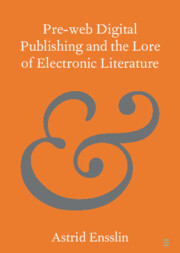10 results
Chapter 12 - Literary Gaming
-
-
- Book:
- The Cambridge Companion to Literature in a Digital Age
- Published online:
- 29 November 2024
- Print publication:
- 14 November 2024, pp 212-232
-
- Chapter
- Export citation

Pre-web Digital Publishing and the Lore of Electronic Literature
-
- Published online:
- 10 March 2022
- Print publication:
- 31 March 2022
-
- Element
- Export citation
9 - From Paratext to Hypertext
- from PART IV - New Ways of Implicating Through the Digital Medium?
-
- Book:
- The Stylistics of ‘You'
- Published online:
- 06 January 2022
- Print publication:
- 13 January 2022, pp 197-220
-
- Chapter
- Export citation
5 - Digital Fiction
- from Part I - Forms
-
-
- Book:
- The Cambridge Companion to Twenty-First Century American Fiction
- Published online:
- 02 September 2021
- Print publication:
- 23 September 2021, pp 100-120
-
- Chapter
- Export citation
26 - Indigenizing the Internet
- from Part IV - Visions and Revisions: 21st-Century Prospects
-
-
- Book:
- The Cambridge History of Native American Literature
- Published online:
- 18 September 2020
- Print publication:
- 17 September 2020, pp 481-500
-
- Chapter
- Export citation
1 - Rewriting, Revision, and Reuse
-
- Book:
- Genres of Rewriting in Second Temple Judaism
- Published online:
- 05 June 2020
- Print publication:
- 11 June 2020, pp 28-55
-
- Chapter
- Export citation
Chapter 16 - The Temple and the Scaffolding
- from Part III - Culture and Politics
-
-
- Book:
- The New Ezra Pound Studies
- Published online:
- 17 October 2019
- Print publication:
- 07 November 2019, pp 257-270
-
- Chapter
- Export citation
Part III - Culture and Politics
-
- Book:
- The New Ezra Pound Studies
- Published online:
- 17 October 2019
- Print publication:
- 07 November 2019, pp 179-276
-
- Chapter
- Export citation
Using Computer Technology to Enhance Agricultural Economics Teaching
-
- Journal:
- Journal of Agricultural and Applied Economics / Volume 27 / Issue 1 / July 1995
- Published online by Cambridge University Press:
- 28 April 2015, pp. 95-100
-
- Article
- Export citation

